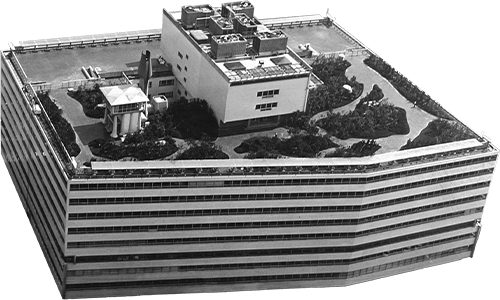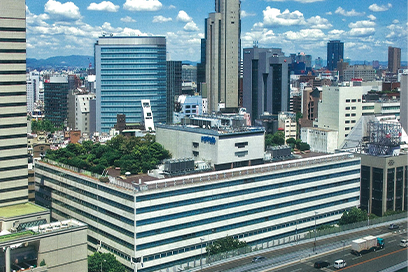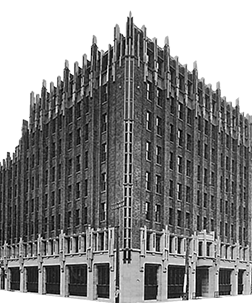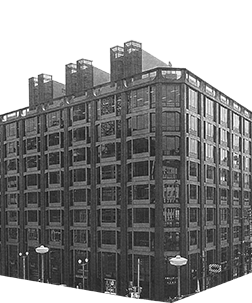 03
1963
03
1963
Osaka
The Shin-Daibiru Building
A Pioneering Office Building That Led the Way
in Large Parking Garages and Rooftop Gardens
A Legacy of Love for Nature
Another revolutionary feature of the North Wing of the Shin-Daibiru Building was the installation of a rooftop garden—the first of its kind in Japan. Tsuneari Fukuda, a famous literary scholar who visited the building, expressed surprise in his description of the garden: “On the roof of this 12-story building, there is an area about 3,300 m2 in size containing an artificial hill, a lawn, 3,759 evergreen trees, 522 deciduous trees, and 1,110 flowering plants, with 100 species of plants. There are also feeders and water troughs to attract wild birds and provide resting places for migratory birds. They’ve even purified the water for the birds’ sake because it was said to contain lime.” Part of the reason for the installation of the rooftop garden was the strong belief of then-president Tomoe Kudo in the protection of nature. He said, “Land development is necessary to sustain and improve human livelihoods. That development takes the form of civil engineering, and it must be admitted that civil engineering the way it is currently done destroys nature, more or less.” After acknowledging this, he expressed the following thoughts: “Human wisdom and our primacy over nature demand that we protect nature and protect the living environment of all living things while we develop the land and promote civil engineering for the benefit of human livelihoods.” The result of Kudo’s deep knowledge of civil engineering, architecture, and nature conservation was revealed in the creation of the rooftop garden.
The concept behind the rooftop garden was later applied to the Yaesu Daibiru Building, and Nakanoshima Shiki-no-oka also installed a garden based on the same concept. The new Shin-Daibiru Building, which was completed in March 2015, carries on the same beliefs. A green space of roughly 3,300 m2 called Dojima-no-mori was established on the premises, and trees and plants from the Shin-Daibiru Building were transplanted there. The rooftop had grown unbelievably thick over the past half century, and there were concerns that this unprecedented transplanting effort might damage the trees, but it was carried out after careful research and planning. Ultimately, 22 trees were successfully transplanted.
The completed Shin-Daibiru Building, including Dojima-no-mori, is the first building in western Japan to be JHEP certified with the highest rank of AAA by the Ecosystem Conservation Society–Japan (ECSJ). It has received high marks for its conservation of biodiversity.
-
1927 1931 Hibiya Daibiru Buildings
No. 1 and No. 2 -
2007 International Operations
-
- An Unexpected Discovery of a Good Property
- Mutual Trust and a Long-Term Perspective as Points of Agreement
- The Acquisition of a Property in Hanoi Through Unity of Philosophy
- Implementing Daibiru Quality Through Building Renovations
- Challenges in Australia, Our Second Overseas Expansion Target
- The Discovery of 275 George Street
- Difficult Contract Negotiations with JHG
- Overcoming Several Unexpected Difficulties
-




